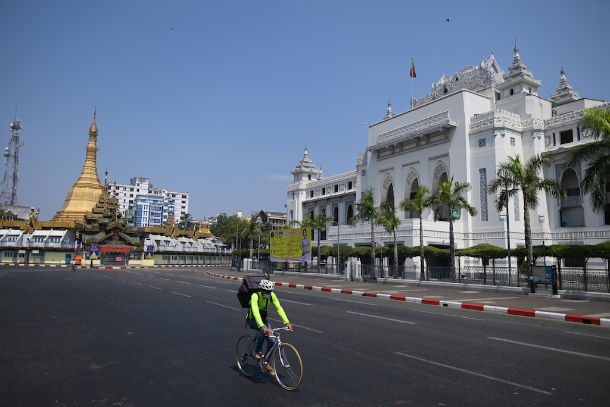A demographic advantage offers hope that the region can avoid a catastrophe

A man cycles along an empty street on the first day of Myanmar’s New Year water festival, known as Thingyan, in Yangon on April 12. Thingyan is normally a week of nationwide celebration and water fights, with soaked revellers partying late into the night, but this year Yangon is in lockdown and silent, its streets eerily empty as coronavirus fears grow. (Photo: Ye Aung Thu/AFP)
April 18, 2020 The normally bustling streets of Myanmar capital Yangon are deserted. All but a few shops selling necessary items have been shuttered. Food markets continue to operate but despite fast-rising temperatures, people are huddled indoors.The scene is even stranger because under normal circumstances the country’s annual New Year festivities, known as Thingyan, would be in full-throated swing with people widely spraying water and millions trekking across the nation to visit family.But the Myanmar government moved two weeks ago to a full lockdown as the impoverished nation’s best hope of weathering the storm of the coronavirus pandemic.The situation in Yangon and Myanmar has been mirrored across Southeast Asia as Covid-19 cases continue to rise despite very limited testing amid growing fears of a catastrophe in a region where medical resources are thin and often non-existent.The populous archipelago nations of Indonesia and the Philippines, with their massive urban sprawls of Jakarta and Manila, look the most vulnerable. But society’s poorest face high risks in smaller nations with limited medical resources such as Myanmar and Timor-Leste.
–Mass on Demand – Wednesday 22 April 2020Sunday Gospel reflection with Father William GrimmReadings of the Day: Wednesday of the Second Week of EasterLord, may I be a source of hope to othersJesus, enable us to hear the cry of the poorSt. SoterThis weekend the entire region is in some form of lockdown, mostly with severe restrictions designed to halt the disease in its tracks. Some see Myanmar and Laos as vulnerable because of their lengthy land borders with China.It is always worth repeating that the poorest people inevitably bear the greatest brunt of health crises such as the Covid-19 pandemic. They often have casual jobs, have no savings to fall back on, work in the shuttered hospitality or tourism sectors, have little or no access to anything but the most basic healthcare, and live in crowded conditions where social distancing is often impossible.Limited testing across the region — only about 300,000 people had been tested as of April 16 — is making is hard to get a grip on both the size of the pandemic’s impact and the expected mortality rate in each country. But experts believe that a greater spread across the region is inevitable due to the hugely contagious nature of the virus and the many people, estimated to be more than 50 percent, who show no symptoms at all.
Many Southeast Asian nations have a demographic advantage. Most have much younger populations than China, western Europe and New York City, where the disease has so far taken its biggest toll. With a combined population of almost 700 million people, the region has about 9 percent of the world’s population with an average age of 30.2 years. Thailand is at the high end with an average of 40.1, while the youthful Philippines averages 25.7.The vast majority of people killed by Covid-19 have been over 65, with people under 50 more likely to display mild or no symptoms and have a less than 1 percent chance of dying.
The region’s most Catholic country by number of followers, the Philippines, whose population of 109 million is the region’s second largest after Indonesia, has reported 5,878 Covid-19 cases and 387 deaths.“Under President Rodrigo Duterte, the Philippine government has veered from dismissing the threat and abstaining from any restrictions on travel and tourism from China to an abrupt move by President Duterte to impose a lockdown on the entire island of Luzon, including Metro Manila, enforced by the military and the police,” the Center for Strategic Independent Studies (CSIS) said.Congress granted Duterte “special temporary power” which allows him to implement draconian measures that are creating extreme hardship, especially for Manila’s massive urban poor.There are fears, too, that Indonesia is facing a Covid-19 catastrophe. Its cases have climbed to 5,923 with 520 deaths but only about 42,000 of its 265 million people have been tested, with President Joko Widodo widely seen to have bungled the country’s initial response.
Thailand, the first country in the world to identify a Covid-19 case outside China, has been slow and inconsistent in its response, underscoring a growing credibility problem for a government led by former coup leader Prayut Chan-o-cha. Its infected toll stands at 2,700 with 47 deaths but only 35,000 people out of 67 million have been tested.“Inconsistent policies about travel and quarantine, poor communication and supply shortages have highlighted the government’s inability to promptly and adequately respond to the surge of Covid-19 cases, resulting in widespread criticism and frustration on social media in Thailand. Prime Minister Prayut has responded with a clampdown on the press and social media reporting,” the CSIS said.But it is the poorest countries like Myanmar, Laos and Cambodia that could face the biggest problem, with the potential upside being stricter lockdowns than in Indonesia or Thailand as they watched wealthy Western countries become enveloped in tragedy. Between them they have tested fewer than 6,000 out of 76 million people and are reliant on wealthy countries like Japan South Korea and Australia donating test kitsThe lockdowns now in place will test whether the killer virus has been slowed, halted or is spreading silently and waiting to strike.






